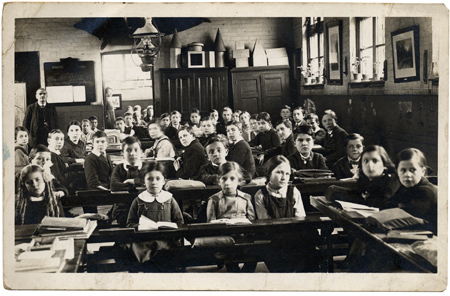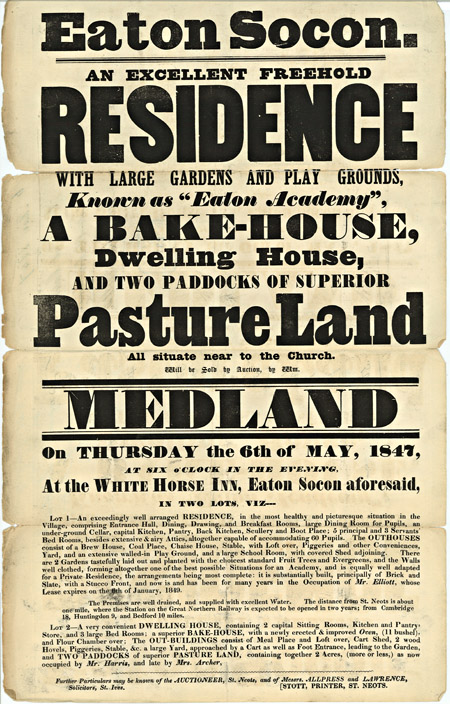Odell Sharnbrook Paths to Crime Walk stop 7 School and School House
Sharnbrook School and School House

A Sharnbrook School class in 1920 [ref.SDSharnbrook4]
A Stolen Umbrella
In October 1854 Mary Spencer, a widow living in the School House at Sharnbrook, was visited by a beggar woman. She refused to give any money but bought some matches from her. Through the window she saw the woman go on up the street past the adjacent schoolroom. Later that day Ann Single, one of the school pupils, went to pick up her umbrella which she had left in the schoolroom porch that morning and found it was missing. Suspicion fell on the match seller who was arrested by police superintendent William Graham Byers. The culprit was found in possession of the umbrella, which she first claimed she had brought from London before changing her story and saying that her husband had exchanged it for another item on the road. The court was not convinced and Mary Cavanagh was sentenced to seven days hard labour.
Mary Cavanagh is described in the gaol register as a 30 year old hawker then resident in Liverpool, although she had been born in Galway, Ireland. Itinerants are hard to trace in the records and so nothing more is known of her. Ann Single was born in 1841 in Felmersham where she lived with her parents until 1865 when she married Thomas Grindon Payne and moved to Sharnbrook. Like her father John, Thomas Payne was a blacksmith. In 1878 Thomas died, leaving his wife Annie a widow with seven children. At this point it becomes apparent that Annie was a capable and resourceful woman, as she took over the running of the blacksmith's business, apparently with some succcess. In the 1881 census she was listed as "carrying on shoeing/smith's business" at Kennell Hill in Sharnbrook with the help of an apprentice blacksmith, and she appears in Kelly's Directory in 1885 as "Payne, Thomas (Mrs) Blacksmith". She was still in business in 1891, but by 1901 had moved to Walthamstow, Essex with her daughter Caroline and family. In 1911 she was living in Kent, still with Caroline.
The old school in Sharnbrook was converted to a schoolroom from stables in 1836 and became the first board school in the county in 1871. Schools appear in the Quarter Sessions records a number of times as the site of offences. At Eaton Socon in 1841 advantage was taken of the charitable nature of John Henry Elliott, the master of a boys' school there.

Notice of the sale of the Eaton Academy in 1847 [ref.WG2376]
Elliott allowed the poor of the neighbourhood to have broth made from the meat cooked for the boys' dinner and also provided dinners for those who applied to himself or his wife for help. In the evidence given by Mr Elliott's servant Edward Catchpole he states that on the evening of Sunday 21 November he had put four tablespoons on the scullery table ready for the cook to wash up on Monday morning. Between six and seven o'clock on Monday morning Rebecca Townsend, a regular "customer", had come to him in the school adjoining the kitchen and asked if there was any broth. He sent her to help herself from the kitchen. At midday it was realised that two of the spoons, worth £2, were missing, but they were at first thought to be mislaid rather than stolen. Townsend returned to the school at one o'clock for a dinner. Several days later Rebecca Townsend and Sarah Smith visited the shops of Julius Isidore Lightstone and a Mr Paxton, both silversmiths and watchmakers at St Neots. In each shop they produced part of a broken spoon and offered it for sale, claiming to have found it in a field. Lightstone, however, became suspicious and retained the broken spoon. Anne Gurney, the school cook, had no doubt that the pieces she was shown were part of Mr Elliott's spoons. Smith was not prosecuted, but Rebecca Townsend was found guilty of stealing and sentenced to four months imprisonment. Seven years later she was convicted again and served another three weeks in the House of Correction, this time for stealing peas.
There are also several other examples of umbrella thefts. One in 1843 was perpetrated by a Polish man, Nikolay Pietrakowski, who was also sentenced to a week in gaol for stealing an umbrella from a doorstep in Bedford. Like Mary Cavanagh he claimed he had obtained the umbrella by exchanging it with "a young Englishman" for an old broken one and an additional shilling. In one instance an umbrella was successfully used as a weapon for self defence by Elizabeth Brightman. The schoolmistress at Pulloxhill School, she was assaulted on the train between Flitwick and Bedford in 1875. In the struggle her umbrella was broken and her assailant Joseph Wooding was told "you have grievously insulted me and you'll suffer for this". He was duly sentenced to six months hard labour.
References: QSR1854/4/5/24; QSR1843/4/5/6; QSR1842/1/5/26; QSR1875/4/5/1; QGV10/3